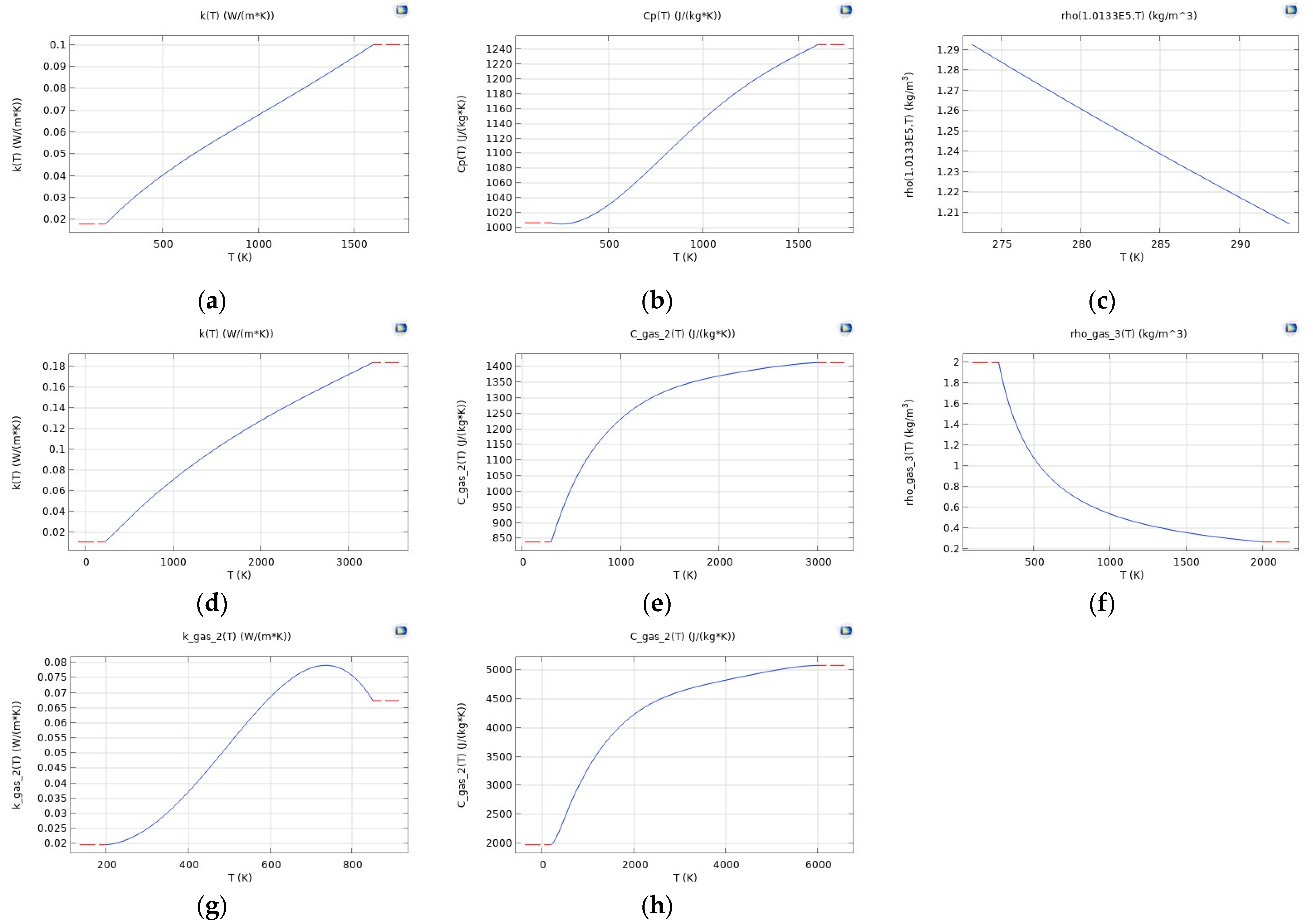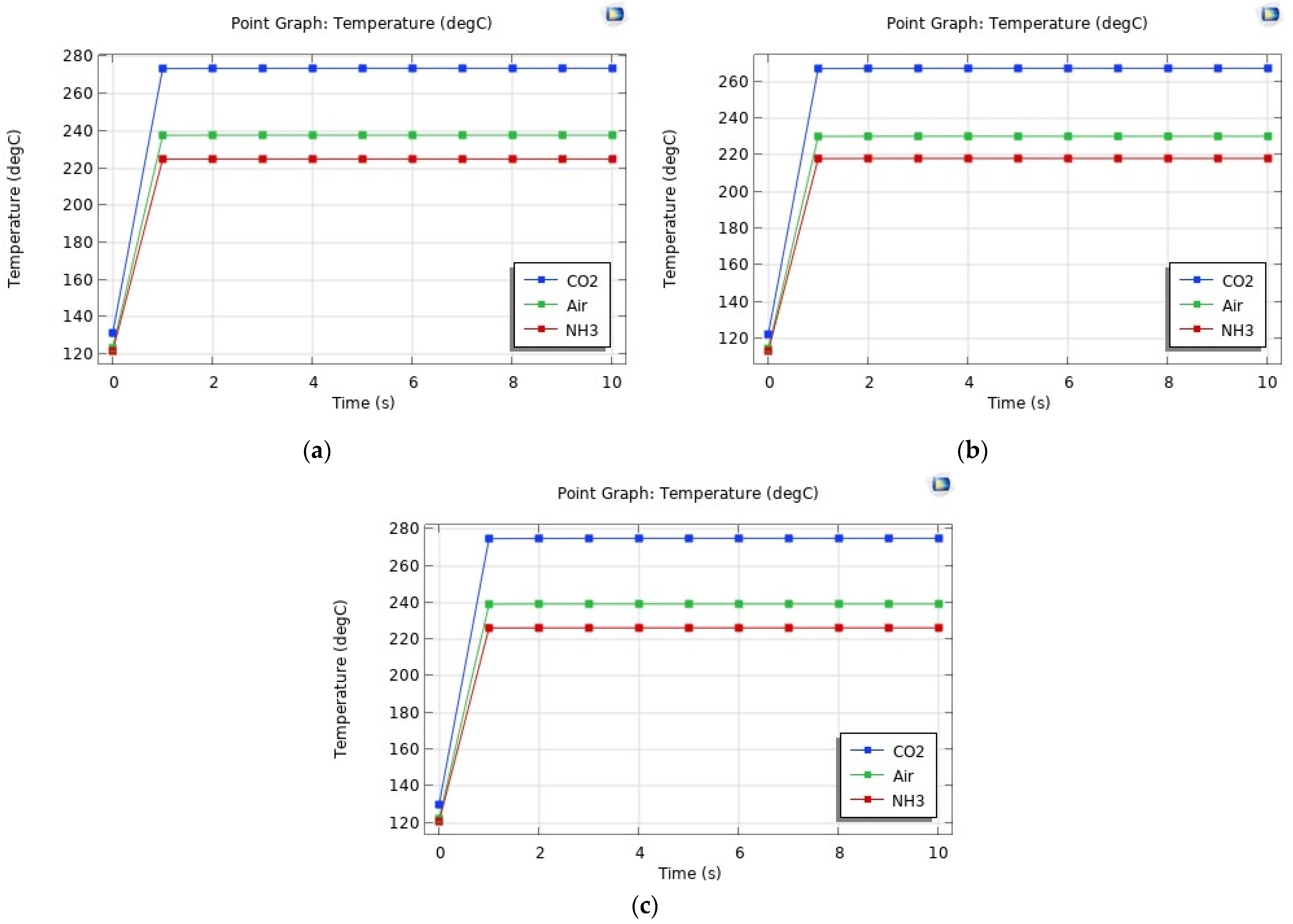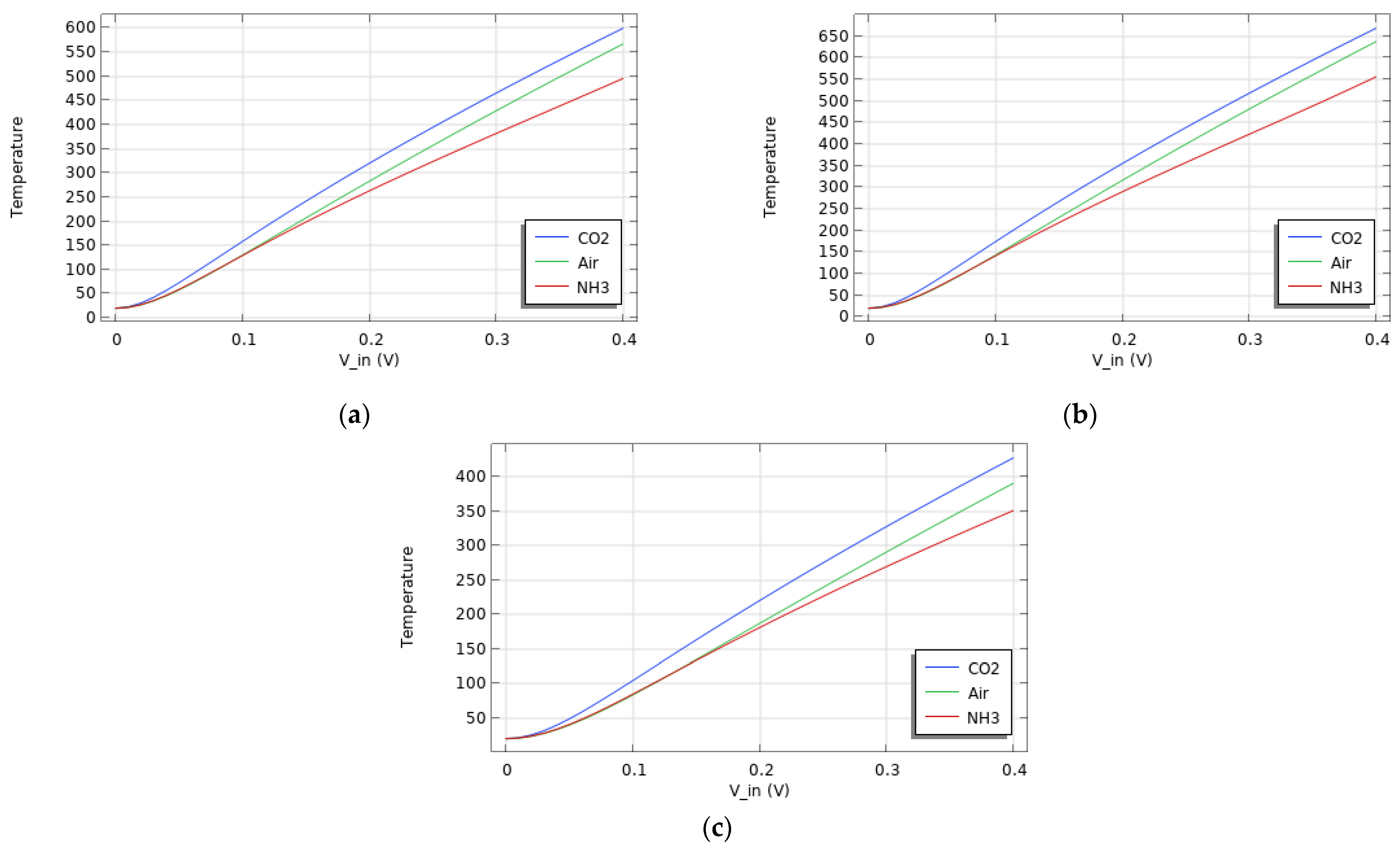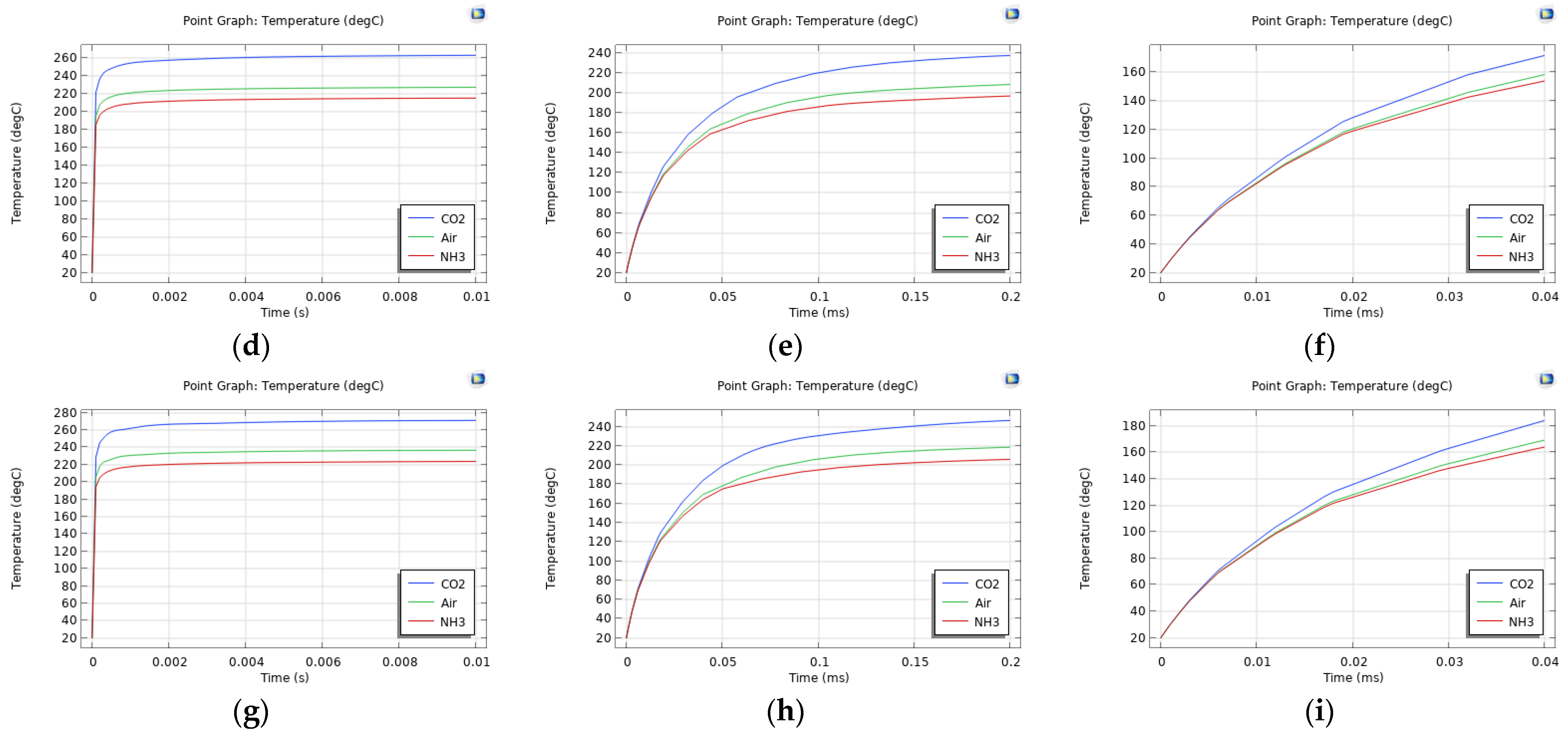Finite Element Simulation Model of Metallic Thermal Conductivity Detectors for Compact Air Pollution Monitoring Devices
Abstract
:1. Introduction
- Catalytic pellistors: Conventionally used for gas detection, these devices consist of an active bead, encasing a platinum coil and treated with a catalyst, to reduce the temperature at which the surrounding gas ignites. When the target gas burns, the active bead heats up and a resistance change proportional to the gas concentration is achieved. There have been microfabrication processing efforts to reduce their typically large power consumption [9,10,11].
- Acoustic techniques: These devices detect the change in the oscillation frequency of an oscillating (e.g., micromachined cantilevers) or piezoelectric material in the presence of a target gas. For instance, a sensitive and selective material can be used as a coating; the adsorption of the target gas on this coating results in a change in mass, and hence, the oscillating frequency [12]. Miniaturisation-compatible, low-power technologies include quartz crystal microbalance (QCM), surface acoustic resonators (SAR), and film bulk acoustic resonators (FBAR).
- Chemiresistive sensors: These devices detect gases through a chemical reaction between the sensing layer and the gas. Metal oxides have traditionally been used for the sensing layer, and their main advantages are their selectivity to some oxidising or reducing gas species, small size, high sensitivity, and fast response [13]; however, these sensors usually require heating [14], and research is still being conducted to reduce their power consumption [11]. Recently, 2D materials, mainly graphene and graphene oxide, have been explored as sensing layers, and their effective gas detection and discrimination have been proven at room temperature [15].
- Electrochemical sensors: These devices exist in two types: potentiometric and amperometric. Potentiometric sensors detect the change in the differential voltage between a working electrode and a reference electrode in the presence of a target gas. Amperometric sensors, on the other hand, are based on an enzyme-catalysed ion exchange between a working electrode and a counter-electrode, which results in a current change in the function of the target gas concentration [12,17].
- Optical sensors: These devices operate based on the principle that gases are able to absorb light in the infrared region, with the absorption profile being specific to each gas [12].
2. Materials and Methods
2.1. Functional Mechanisms of TCD Gas Sensors
2.2. FEM Workflow
- Building the geometry.
- Assigning a material to each part of the geometry.
- Choosing suitable physics and boundary conditions—COMSOL also has Multiphysics nodes, which allows us to combine two physics and observe their combined effects.
- Meshing the geometry.
- Choosing a study and simulating the model.
- Postprocessing the results.
2.3. Geometry and Materials
2.4. Physics
- : reference temperature, considered to be 20 °C (293.15 K);
- : reference resistivity at ;
- : resistivity temperature coefficient (TCR).
2.5. Meshing
2.6. Study
3. Results and Discussion
3.1. Centre Temperature
- Au, Al, and W, respectively, require increasing input voltages for the electrode to reach the same temperature range.
- NH3 results in a lower electrode temperature, while CO2 results in a higher one, compared to air, regardless of the electrode material.
3.2. Current and Resistance
- The resistance values in Table 2 are higher than the cold resistances mentioned in Section 3.1 due to the heating effect.
- The presence of NH3 results in a lower resistance than air, while CO2 results in a higher resistance. This is related to the second observation made in Section 3.1 and the linear relationship between temperature and resistance.
- The current no longer increases linearly with the input voltage because the resistance is changing. Plotting the resistance as a function of the input voltage, the graphs in Figure 6 are obtained.
- Once again, it is confirmed that CO2 results in higher resistance than air, while NH3 produces lower resistance.
- There is a linear relationship between resistance and the applied voltage.
- At low voltages, the difference in resistance between the 3 gases is minimal. Therefore, in order to obtain better sensor performance, it is recommended to use input voltages over 0.15 V for Al and Au, and 0.2 V for W. The higher the input voltage, the more obvious the difference in the resistance values; but in actual devices, it is important to consider the fuse effect so as not to blow the electrodes.
3.3. Voltage and Temperature
3.4. Transient Behavior
4. Conclusions
- The material resistivity, which determines the electrode resistance, influences the input voltage level required for the electrode to reach a specific temperature: higher voltages are required for higher resistances/resistivities, and vice versa.
- The gas thermal conductivity, which determines the amount of heat dissipation, influences the electrode temperature. At a set input voltage, and regardless of the electrode material, a gas with higher thermal conductivity results in a lower electrode temperature, and vice versa.
- Building upon the previous point, the current flow in the electrode, and hence, its resistance, depend on its temperature. A gas with higher thermal conductivity results in lower electrode resistance and a higher current.
- The higher the TCR of the electrode material, the higher the sensitivity.
- There is a linear relationship not only between resistance and temperature, but also between resistance and voltage, and temperature and voltage.
- Based on the above, W is the best electrode material in terms of sensitivity, but it also induces higher power consumption (higher resistance and required input voltage). Au, on the other hand, has the lowest sensitivity, but draws the least power.
Author Contributions
Funding
Institutional Review Board Statement
Informed Consent Statement
Data Availability Statement
Acknowledgments
Conflicts of Interest
References
- GOV.UK. Air Pollution: Applying All Our Health. Available online: https://www.gov.uk/government/publications/air-pollution-applying-all-our-health/air-pollution-applying-all-our-health (accessed on 10 October 2022).
- World Health Organization (WHO). Ambient (Outdoor) Air Pollution. Available online: https://www.who.int/news-room/fact-sheets/detail/ambient-(outdoor)-air-quality-and-health (accessed on 29 June 2023).
- European Environment Agency. Carbon Dioxide, CO2. Available online: https://www.eea.europa.eu/help/glossary/eper-chemicals-glossary/carbon-dioxide-co2 (accessed on 29 June 2023).
- Buis, A. The Atmosphere: Getting a Handle on Carbon Dioxide. Available online: https://climate.nasa.gov/news/2915/the-atmosphere-getting-a-handle-on-carbon-dioxide/ (accessed on 13 September 2023).
- Konuk Ege, G.; Yüce, H.; Genç, G. A Gas Sensor Design and Heat Transfer Simulation with ZnO and TiO2 Sensing Layers. MANAS J. Eng. 2021, 9, 37–44. [Google Scholar] [CrossRef]
- New York State Department of Health. The Facts about Ammonia. Available online: https://www.health.ny.gov/environmental/emergency/chemical_terrorism/ammonia_tech.htm (accessed on 29 June 2023).
- GOV.UK.; Public Health England. Health Matters: Air Pollution. Available online: https://www.gov.uk/government/publications/health-matters-air-pollution (accessed on 26 June 2023).
- WHO. Global Air Quality Guidelines; WHO: Geneva, Switzerland, 2021. [Google Scholar]
- SGX Sensortech. Introduction to Pellistor Gas Sensors. In A1A-Pellistor Intro; SGX Sensortech: Neuchâtel, Switzerland, 2007. [Google Scholar]
- Crowcon Detection Instruments Ltd. Pellistor Sensors—How They Work. Available online: https://www.crowcon.com/blog/pellistor-sensors-how-they-work/ (accessed on 26 June 2023).
- Aguilar, R. Ultra-Low Power Microbridge Gas Sensor. Ph.D. Thesis, Georgia Institute of Technology, Atlanta, GA, USA, 2012. [Google Scholar]
- Oluwasanya, P.W. Portable and Non-Intrusive Sensors for Monitoring Air Pollution PM2.5 and NO2. Ph.D. Thesis, University of Cambridge, Cambridge, UK, 2019. [Google Scholar]
- Arun, K.; Lekshmi, M.S.; Suja, K.J. Design and Simulation of ZnO based Acetone Gas Sensor using COMSOL Multiphysics. In Proceedings of the 7th International Conference on Signal Processing and Integrated Networks (SPIN), Noida, India, 27–28 February 2020; pp. 659–662. [Google Scholar]
- Donarelli, M.; Ottaviano, L. 2D Materials for Gas Sensing Applications: A Review on Graphene Oxide, MoS₂, WS₂ and Phosphorene. Sensors 2018, 18, 3638. [Google Scholar] [CrossRef] [PubMed]
- Rabchinskii, M.K.; Sysoev, V.V.; Glukhova, O.E.; Brzhezinskaya, M.; Stolyarova, D.Y.; Varezhnikov, A.S.; Solomatin, M.A.; Barkov, P.V.; Kirilenko, D.A.; Pavlov, S.I.; et al. Guiding Graphene Derivatization for the On-Chip Multisensor Arrays: From the Synthesis to the Theoretical Background. Adv. Mater. Technol. 2022, 7, 2101250. [Google Scholar] [CrossRef]
- Lundström, K.; Shivaraman, M.; Svensson, C. A hydrogen-sensitive Pd-gate MOS transistor. J. Appl. Phys. 1975, 46, 3876–3881. [Google Scholar] [CrossRef]
- McAleer, J.F.; Law, J.T.; Morris, R.A.; Scott, L.; Mellor, J.M.; Dennison, M. Enhanced Amperometric Sensor. U.S. Patent 5,264,106, 23 November 1993. [Google Scholar]
- Gardner, E.L.W.; Gardner, J.W.; Udrea, F. Micromachined Thermal Gas Sensors-A Review. Sensors 2023, 23, 681. [Google Scholar] [CrossRef] [PubMed]
- Scorzoni, A.; Baroncini, M.; Placidi, P. On the relationship between the temperature coefficient of resistance and the thermal conductance of integrated metal resistors. Sens. Actuators A Phys. 2004, 116, 137–144. [Google Scholar] [CrossRef]
- COMSOL. Setting up and Running a Simulation with COMSOL Multiphysics®. Available online: https://www.comsol.com/video/setting-up-and-running-a-simulation-with-comsol-multiphysics (accessed on 29 June 2023).
- COMSOL. AC/DC Module User’s Guide; COMSOL: Bengaluru, India, 2018. [Google Scholar]
- HyperPhysics—Department of Physics and Astronomy, Georgia State University. Resistivity and Temperature Coefficient at 20 °C; Department of Physics and Astronomy, Georgia State University: Atlanta, GA, USA; Available online: http://hyperphysics.phy-astr.gsu.edu/hbase/Tables/rstiv.html (accessed on 1 July 2024).
- Electronics Notes. Temperature Coefficient of Resistance. Available online: https://www.electronics-notes.com/articles/basic_concepts/resistance/resistance-resistivity-temperature-coefficient.php (accessed on 29 June 2023).
- COMSOL. Heat Transfer Module User’s Guide; COMSOL: Bengaluru, India, 2022. [Google Scholar]
- Palmer, P.E.; Weaver, E.R. Thermal-Conductivity Method for the Analysis of Gases; Technologic Papers of the Bureau of Standards; US Department of Commerce: Washington, DC, USA, 1924; Volume 18.









| Material Property | Al | Au | W |
|---|---|---|---|
| Heat capacity at constant pressure [J/(kg·K)] | 904 | 129 | 132 |
| Density (kg/m3) | 2700 | 19300 | 19350 |
| Thermal conductivity [W/(m·K)] | 237 | 317 | 174 |
| Relative permittivity | 1.55 | 6.9 | 1 |
| Reference resistivity (Ω·m) | 2.65 × 10−8 | 2.40 × 10−8 | 5.60 × 10−8 |
| Resistivity temperature coefficient TCR (1/K) | 0.00429 | 0.0034 | 0.0045 |
| Reference temperature (K) | 293.15 | 293.15 | 293.15 |
| Electrical conductivity (S/m) | 3.55 × 107 | 4.56 × 107 | 2.00 × 107 |
| Coefficient of thermal expansion (1/K) | 2.31 × 10−5 | 1.42 × 10−5 | 4.50 × 10−6 |
| Young’s modulus (Pa) | 7.00 × 1010 | 7.00 × 1010 | 4.11 × 1011 |
| Poisson’s ratio | 0.35 | 0.44 | 0.28 |
| CO2 | Air | NH3 | %ΔCO2 | %ΔNH3 | |
|---|---|---|---|---|---|
| Al | 16.088 | 14.872 | 14.461 | 8.176 | 2.765 |
| Au | 12.887 | 11.991 | 11.709 | 7.466 | 2.357 |
| W | 34.845 | 32.170 | 31.261 | 8.314 | 2.827 |
| Material | Gas | T0.04ms (°C) | T0.04ms/T10s (%) | R0.04ms (Ω) | R0.04ms/R10s (%) |
|---|---|---|---|---|---|
| Al | Air | 173.34 | 72.89 | 12.81 | 86.14 |
| CO2 | 183.83 | 67.14 | 13.19 | 82.00 | |
| NH3 | 167.59 | 74.47 | 12.63 | 87.35 | |
| Au | Air | 158.51 | 68.84 | 10.33 | 86.12 |
| CO2 | 171.86 | 64.29 | 10.66 | 82.71 | |
| NH3 | 154.04 | 70.59 | 10.22 | 87.33 | |
| W | Air | 169.36 | 70.76 | 27.28 | 84.79 |
| CO2 | 184.17 | 66.96 | 28.44 | 81.61 | |
| NH3 | 164.18 | 72.53 | 26.93 | 86.13 |
Disclaimer/Publisher’s Note: The statements, opinions and data contained in all publications are solely those of the individual author(s) and contributor(s) and not of MDPI and/or the editor(s). MDPI and/or the editor(s) disclaim responsibility for any injury to people or property resulting from any ideas, methods, instructions or products referred to in the content. |
© 2024 by the authors. Licensee MDPI, Basel, Switzerland. This article is an open access article distributed under the terms and conditions of the Creative Commons Attribution (CC BY) license (https://creativecommons.org/licenses/by/4.0/).
Share and Cite
Mallah, J.; Occhipinti, L.G. Finite Element Simulation Model of Metallic Thermal Conductivity Detectors for Compact Air Pollution Monitoring Devices. Sensors 2024, 24, 4683. https://doi.org/10.3390/s24144683
Mallah J, Occhipinti LG. Finite Element Simulation Model of Metallic Thermal Conductivity Detectors for Compact Air Pollution Monitoring Devices. Sensors. 2024; 24(14):4683. https://doi.org/10.3390/s24144683
Chicago/Turabian StyleMallah, Josée, and Luigi G. Occhipinti. 2024. "Finite Element Simulation Model of Metallic Thermal Conductivity Detectors for Compact Air Pollution Monitoring Devices" Sensors 24, no. 14: 4683. https://doi.org/10.3390/s24144683







